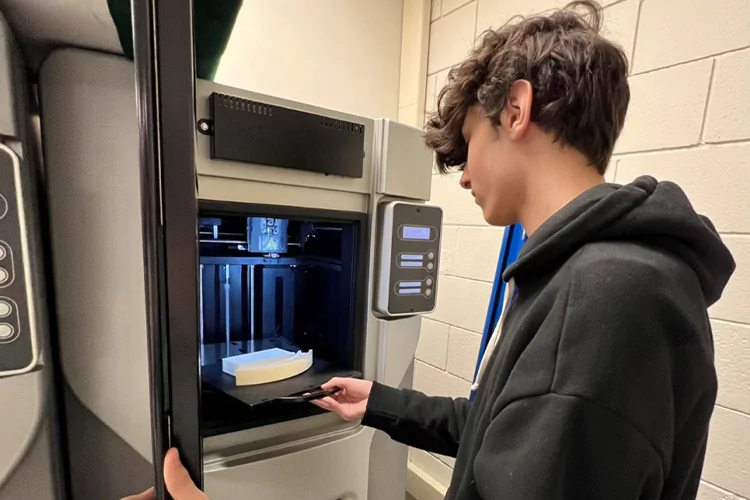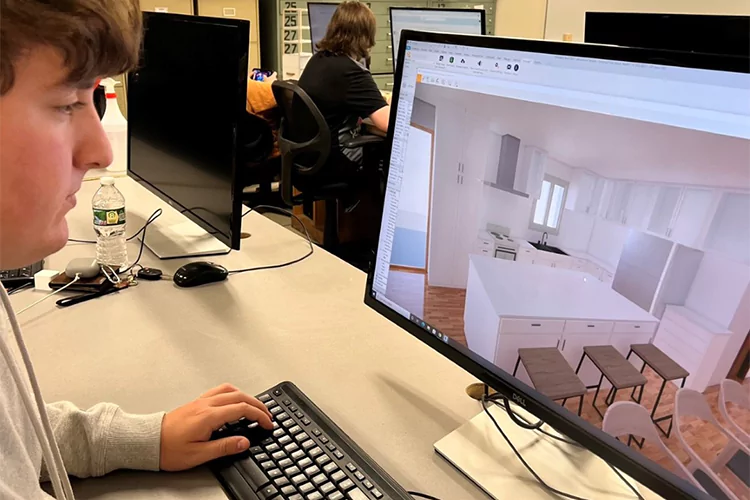Drafting
What is Drafting?
Drafters are planners for the design, manufacturing, and construction industries. They create the technical drawings required to fabricate and communicate ideas. Drafters implement industry standards so that drawings can be easily understood by a wide range of industries that require their services.
This four-year course provides students with an introduction to drafting as a graphic communicative language, for a multitude of industries, with general focus on the competencies that serve as the underpinnings of mechanical and architectural design. The general curriculum focuses on the basics of computer aided drafting (CAD), drawing techniques and drafting fundamentals as a foundation for visualizing and understanding industry practices. Conceptualizing, drawing, and building are the processes that students will utilize on all projects. Students will gain direct knowledge in the areas mechanical and architectural drafting and a variety of adjacent supportive career areas such aerospace, electro mechanical, robotics, civil engineering, structural engineering, industrial design, and interior design, etc.
Mechanical
This course provides students with an introduction to mechanical drawing and design. Students can expect to acquire drafting knowledge in the following content areas; orthographic projection, basic and advanced geometric constructions, section views, threads and fasteners, welding drawings, manufacturing processes, development drawings, and assembly drawings. Students also study gear fundamentals including spur, bevel, worm, and rack & pinion gear drawings. Various industry processes are examined including casting, forging, welding and flat pattern sheet metal developments. Students explore material finishes, strength of materials, precision measuring, tolerancing, fits, limits, clearance hole diameters and geometric dimensioning and tolerancing. Instruction incorporates various types of CAD software such as Auto-Cad and parametric modeling with Solid Works to generate exploded assembly drawings, presentation drawings and a variety of working drawings. Students will utilize 3D laser scanning and 3D printer technologies to enhance design skills through reverse engineering and prototype models. Students may have the opportunity to apply their mechanical drafting skills to a variety of circumstances including co-op, client projects, shop collaborations, and robotics. Instruction incorporates presentations, demonstration, and hands on performance testing in the areas of mechanical drafting. Research, including reading, writing, and math assignments related to the mechanical drafting profession, are integrated with academic frameworks and instruction incorporates demonstrations and testing using competency-based vocational education (CBVE) for mechanical drafting standards.
Architectural
This course provides students with an introduction to residential architectural drawing and design. Students can expect to acquire knowledge in spacial planning, site design and sustainable building concepts, structural framing and mechanical, electrical, and plumbing design diagrams. Students will understand the development of drawings within the context of state and local building codes and permitting processes. Students will utilize building information modeling (BIM) software such as Revit, to accurately generate floor plans, elevations, foundation plans, foundation sections, framing plans, building sections, and typical wall section/detail drawings. Enscape and Lumion presentation renderings and virtual reality walk-throughs are used by students to present ideas and concepts to teachers, piers, and outside clients. Students may have the opportunity to apply their architectural drafting skills to a variety of circumstances including co-op, client projects, and the annual Bay Path house project. Research, including reading, writing, and math assignments related to the architectural drafting profession, are integrated with academic frameworks and instruction incorporates demonstrations and testing using competency-based vocational education (CBVE) for architectural drafting standards.
What does Drafting look like at Bay Path?

Architecture/Civil Engineering – Physical Model Building

Architectural Visualization - Enscape Rendering

Design Process Prototypes / Utilizing 3D Printer Technology

Freshman Year Tower Design Project- Autocad to Physical Model

Mechanical Engineering – Parametric Modeling with Solid Works

Interior Design – Autodesk Revit
Drafting Staff
| Title | Name | Extra Help | Extension | |
|---|---|---|---|---|
| Related Theory Instructor | Vaillancourt, Jonathan | jvaillancourt@baypath.net | Wednesday | x1120 |
| Shop Instructor (All Grades) | White, Michael | mwhite@baypath.net | Tuesday | x1325 |
